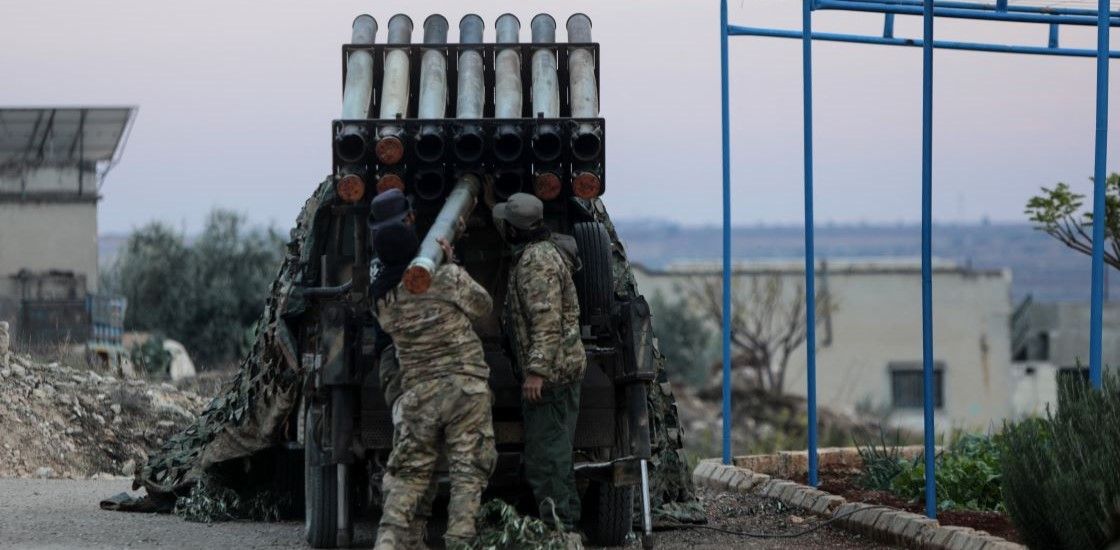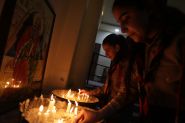- Home
- Middle East
- Syrian Rebels Capture Strategic City of Hama, Vow to Target Homs Next

Anti-government fighters load a multi-barrel rocket launcher before firing against regime forces, in the northern outskirts of Syria's west-central city of Hama on December 4, 2024. ©Bakr Al Kassem / AFP
Islamist-led rebel forces captured the central Syrian city of Hama on Thursday, days after seizing the country's commercial hub Aleppo in a lightning offensive against President Bashar al-Assad's forces.
Rebel forces spokesman Hassan Abdel Ghani was quick to announce on Telegram that, after the fall of Hama, Homs was now the new target of their offensive, which prompted the Lebanese army to deploy units near the northeastern border with Syria as a preemptive measure.
The rebels led by the Islamist group Hayat Tahrir al-Sham (HTS) launched their offensive little more than a week ago, just as a ceasefire took hold between Israel and Assad's ally Hezbollah.
Following overnight clashes, the rebels stormed Hama "from several sides" and engaged in street battles with Assad's forces, said the Syrian Observatory for Human Rights war monitor.
The rebels said they seized Hama's prison and released its inmates. By the afternoon, Syria's army admitted losing control of the city, strategically located between Aleppo and Assad's power base in the capital Damascus.
"Over the past few hours, with the intensification of confrontations between our soldiers and terrorist groups... these groups were able to breach a number of axes in the city and enter it," the army said in a statement, adding units had redeployed outside Hama.
Furthermore, Syrian air defenses shot down two "enemy" drones over Damascus on Thursday, state news agency SANA reported, citing a military source.
"A short time ago, our air defences confronted enemy drone aircraft in the skies over Damascus," the statement from the military source said, adding that "two aircraft were shot down, without any human or material losses."
“No revenge”
In a video posted online, HTS leader Abu Mohammed al-Jolani said his fighters had entered Hama to "cleanse the wound that has endured in Syria for 40 years," referring to a crackdown on the Muslim Brotherhood in 1982, which led to thousands of deaths.
"I ask God almighty that it be a conquest with no revenge," he added.
The rapid fall of the city came despite shelling and strikes by the Syrian and Russian air forces, as reported by state media late Wednesday.
Maya, a 22-year-old student who gave only her first name for security concerns, said earlier Thursday that she and her family were staying at home as the fighting raged outside.
"We have been hearing non-stop the sounds of explosions and shelling," she told AFP by telephone from Hama.
"We don't know what's going on outside."
Rebel leader tours citadel
The Observatory, which relies on a network of sources in Syria, says 826 people, mostly combatants but also 111 civilians, have been killed in Syria since the violence erupted last week.
It marks the most intense fighting since 2020 in a country already ravaged by civil war, which began with the repression of pro-democracy protests in 2011.
Key to the rebels' successes since the start of the offensive last week was the takeover of Aleppo, which in more than a decade of war had never entirely fallen out of government hands.
Jolani, the HTS chief, on Wednesday visited Aleppo's landmark citadel, where images posted on the rebels' Telegram channel showed him waving to supporters from an open-top car.
While the advancing rebels found little resistance earlier in their offensive, the fighting around Hama has been especially fierce.
Assad ordered a 50-percent raise in career soldiers' pay, SANA reported, as he seeks to bolster his forces for the counteroffensive.
Rebels drove back the Syrian armed forces despite the government's sending in "large military convoys," according to the Observatory.
The monitor said the fighting on Wednesday was close to an area mainly populated by Alawites, followers of the same offshoot of Shiite Islam as the president.
Layal Abou Rahal, with AFP
Read more



Comments